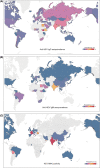The global epidemiology of hepatitis E virus infection: A systematic review and meta-analysis
- PMID: 32281721
- PMCID: PMC7384095
- DOI: 10.1111/liv.14468
The global epidemiology of hepatitis E virus infection: A systematic review and meta-analysis
Abstract
Background and aims: Hepatitis E virus (HEV), as an emerging zoonotic pathogen, is a leading cause of acute viral hepatitis worldwide, with a high risk of developing chronic infection in immunocompromised patients. However, the global epidemiology of HEV infection has not been comprehensively assessed. This study aims to map the global prevalence and identify the risk factors of HEV infection by performing a systematic review and meta-analysis.
Methods: A systematic searching of articles published in Medline, Embase, Web of science, Cochrane and Google scholar databases till July 2019 was conducted to identify studies with HEV prevalence data. Pooled prevalence among different countries and continents was estimated. HEV IgG seroprevalence of subgroups was compared and risk factors for HEV infection were evaluated using odd ratios (OR).
Results: We identified 419 related studies which comprised of 1 519 872 individuals. A total of 1 099 717 participants pooled from 287 studies of general population estimated a global anti-HEV IgG seroprevalence of 12.47% (95% CI 10.42-14.67; I2 = 100%). Notably, the use of ELISA kits from different manufacturers has a substantial impact on the global estimation of anti-HEV IgG seroprevalence. The pooled estimate of anti-HEV IgM seroprevalence based on 98 studies is 1.47% (95% CI 1.14-1.85; I2 = 99%). The overall estimate of HEV viral RNA-positive rate in general population is 0.20% (95% CI 0.15-0.25; I2 = 98%). Consumption of raw meat (P = .0001), exposure to soil (P < .0001), blood transfusion (P = .0138), travelling to endemic areas (P = .0244), contacting with dogs (P = .0416), living in rural areas (P = .0349) and receiving education less than elementary school (P < .0001) were identified as risk factors for anti-HEV IgG positivity.
Conclusions: Globally, approximately 939 million corresponding to 1 in 8 individuals have ever experienced HEV infection. 15-110 million individuals have recent or ongoing HEV infection. Our study highlights the substantial burden of HEV infection and calls for increasing routine screening and preventive measures.
Keywords: epidemiology; hepatitis E virus; prevalence; risk factors; seroprevalence.
© 2020 John Wiley & Sons A/S. Published by John Wiley & Sons Ltd.
Conflict of interest statement
The authors do not have any disclosures to report.
Figures




Comment in
-
Hepatitis E prevalence in indigenous communities from Western Brazilian Amazon.Liver Int. 2021 Jan;41(1):235-236. doi: 10.1111/liv.14679. Epub 2020 Nov 6. Liver Int. 2021. PMID: 33155389 No abstract available.
-
Author response to Letter to the Editor: Hepatitis E prevalence in indigenous communities from Western Brazilian Amazon.Liver Int. 2021 Jan;41(1):234. doi: 10.1111/liv.14717. Epub 2020 Nov 17. Liver Int. 2021. PMID: 33156554 No abstract available.
References
-
- Khuroo MS, Kamili S. Aetiology, clinical course and outcome of sporadic acute viral hepatitis in pregnancy. J Viral Hepat. 2003;10(1):61‐69. - PubMed
-
- Kamar N, Selves J, Mansuy J‐M, et al. Hepatitis E virus and chronic hepatitis in organ‐transplant recipients. N Engl J Med. 2008;358(8):811‐817. - PubMed
-
- Zhou X, de Man RA, de Knegt RJ, Metselaar HJ, Peppelenbosch MP, Pan Q. Epidemiology and management of chronic hepatitis E infection in solid organ transplantation: a comprehensive literature review. Rev Med Virol. 2013;23(5):295‐304. - PubMed
-
- Zhou J‐H, Li X‐R, Lan XI, et al. The genetic divergences of codon usage shed new lights on transmission of hepatitis E virus from swine to human. Infect Genet Evol. 2019;68:23‐29. - PubMed
Publication types
MeSH terms
Substances
LinkOut - more resources
Full Text Sources

